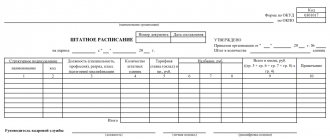Any work is much more effective when work time is organized wisely, in accordance with the needs of employees and employers, while not contradicting current laws. To ensure such an organization, there is a labor organization regime based on flexible working hours (GW).
- What are the features of such a special schedule?
- On whose initiative is it being introduced? How is labor accounted for?
- Is the employee’s desire to transfer him to such a schedule sufficient, and will the employer’s refusals be lawful?
Is it possible to set flexible working hours for an external part-time worker ?
Types of flexible work schedules
A flexible work schedule is a variant of organizing work time in which individual employees or teams of enterprises can (within established limits) work under conditions of self-regulation of the beginning, end and duration of the working day.
When applying the regime under consideration, it is imperative to work the total number of working hours determined by law during the accounting period (day, week, month, etc.).
The elements that make up the mode are as follows:
- variable (flexible) time at the beginning (end) of the work day (shift), within which the employee has the right (at his own discretion) to start and finish working;
- fixed time - the period during which those who have a flexible working time schedule are required to stay at the workplace;
- a break (for food), the duration of which is not actually included in working hours;
- the duration (type) of the accounting period, which establishes the time during which the employee is obliged to work the standard of time established by the legislator (this can be a day, a week, a month, etc.).
Possible mode options, which depend on the duration of the accounting period, are:
- accounting period equated to a working day (the duration established by the legislator is worked out in full on the same day);
- accounting period equal to a week (the length of the week, established in hours of work, is worked in full this week);
- accounting period equal to a month (a certain number of hours is worked in full in a given month).
Sometimes the following are used as an accounting period:
- decade;
- quarter;
- other mode options acceptable to the enterprise.
As a result, the duration of the accounting period can range from one working day to a year (Article 102, Part 1 of Article 104 of the Labor Code of the Russian Federation).
Sliding weekend
A rolling schedule is a type of flexible schedule. In this case, the employee works a fixed number of days, then receives the required number of days off.
During normal operation, days off are provided on the same days. In this case, they will constantly move.
One example could be the work of a watchman according to the following schedule: he works for a day, then rests for three days.
This case has its positive and negative sides. Taking days off at regular intervals gives you the opportunity to adjust to your work rhythm.
However, since most people get Saturday and Sunday off, such a worker will often be at odds with them, resting when most people have working days.
In many cases, flexible scheduling is associated with higher work intensity or longer shifts.
How flexible working can improve your life, see here:
Flexible schedule and its features
Let us tell you in more detail how to understand a “flexible schedule” and what its features are. This is a system in which the employer has the opportunity to set an individual working day for an employee.
Working according to the “g” schedule - what is it? This is the performance of state or public duties, identical for registration both in form T-12 and in form 0504421. Does this equate to the opportunity to come to the workplace when it is convenient for the employee? This is not an option, of course. In this case, the employer determines the scope of the task and the deadline for its completion. This is the work used at many foreign enterprises (for example, at Sony); Is there a flexible schedule at enterprises in our country: of course, yes, but this format is still new for the most advanced corporations.
This work regime is a form of work in which individual employees or teams as a whole can start and end the working day, as well as determine its duration within the framework of an agreement reached with the employer. However, in this case it is necessary to work out the total established standard number of labor hours in full in the agreed accounting period.
This mode is set:
- internal labor regulations (part 1 of article 100 of the Labor Code of the Russian Federation);
- an employment contract with a specific employee (if a regime is defined for him that differs from that generally accepted in the organization).
Decor
It is important to remember that work and rest hours are one of the mandatory conditions of an employment contract. Everything that the employee and employer agree on must be recorded on paper. Any verbal agreements may be ignored or misinterpreted. If the employee’s employment contract stipulates a work schedule from 09:00, he must be on site at this time, otherwise the employer has the right to record lateness. And absence of more than 4 hours is interpreted as absenteeism, which entails disciplinary measures.
If an employee and the company agree on GGR before employment, this must immediately be reflected in the employment contract. And if there is a need to introduce a new schedule into the employment contract of an existing employee, then an employee’s application for a change of regime, agreed upon by the manager, is required in order to make changes to the contract on its basis using an additional agreement to it. Full-time work and a flexible schedule can most often coexist simultaneously, but the use of a flexible schedule is not excluded when applying for a part-time or weekly work schedule.
How to set a flexible schedule for an employee
Flexible work schedule - what is it? Free from obligations? The answer to the question is this: this is a clear system based on strict control and labor discipline. What does a full-time, flexible schedule mean for any employee? The latter concept implies the need for an employee to be present at the workplace for a set number of hours, without taking into account the lunch break.
In order to establish a flexible schedule (according to the Labor Code of the Russian Federation), it is necessary to agree on it between the employee and the employer. This can be done both upon admission to the institution and during work at the enterprise. The reasons for establishing such a work regime may be:
- household, social, and other conditions under which it is not possible to continue working as usual;
- economical use of working time, improving the atmosphere in the department, increasing labor productivity.
Article 102 of the Labor Code of the Russian Federation determines the possibility of establishing a flexible schedule, within which the beginning, end, and duration of work are determined by formalizing an agreement of the parties.
Thus, work on a flexible schedule is a work week of a set duration (for example, 40 hours), within which the working day can consist of 4, 8, 12 hours, but in total the employee must return to work by the end of the accounting period (week) at 40 o'clock. Employees whose work is based on such rules have the same social package from the employer as those working under the regular system: weekends, vacation, sick leave and other payments. This means that the use of such a regime does not affect the payment procedure, the procedure for calculating and the amount of payments, benefits, length of service and other labor rights.
Information that the employee has been assigned a flexible mode is indicated:
- when hiring - in an employment order issued on the basis of a concluded employment agreement (the employer has the right to use both the unified T-1 form and an independently developed one);
- in the process of work - in the text of the concluded additional agreement to the employment contract (upon signing the document, the employer issues an administrative document on the application of the working hours for a certain employee. The additional agreement with the employee must be indicated as the basis for the document. The employer can develop the form of the document himself. It must indicate position, full name of the employee for whom the regime is determined, date of introduction, fixed and variable time, break time for rest and food, duration of the accounting period. The document must be familiarized with the subordinate for signature).
When to set this mode
Flexible working hours are established in cases where the usual work schedule cannot be applied within a particular organization. The reasons for this can be very different, ranging from social to everyday.
A similar schedule would be appropriate for both a five-day and a six-day work week. It does not matter in what field of activity such a working day is established. In addition, the establishment of a flexible way of carrying out work is also possible in other modes fixed in the Labor Code of the Russian Federation. This is due to the fact that, despite some self-government on the part of the organization’s employees, this does not affect the standardization or calculation of wages specified in the agreement between the participants in the labor relationship.
But at the same time, a flexible work schedule is considered the most convenient for specialists in the following professional fields:
- sales. In this case, we are talking about realtors and agents working with real estate, promoters, managers and other employees directly related to the market.
- Creation. A flexible work schedule will be the best option for creative individuals, in particular, photographers, actors, designers, artists, illustrators, etc.
- Advertising and IT technologies, etc.
In addition, a flexible work schedule will be the best option for women who have young children. This is due to the fact that thanks to work planning, it is possible to avoid tardiness and absenteeism associated, for example, with transporting a child to kindergarten or school.
All necessary conditions are specified in the employment contract between employees and the employer, which is a guarantee of respect for the rights and interests of participants in legal relations.
Why is it attractive to performers?
The method of organizing work according to the option under consideration has many advantages for the employee (provided he properly performs his duties):
- independent planning of the day in a convenient format;
- coming and going at a convenient time;
- independent choice of day length;
- motivation to improve performance, based on a sense of freedom and trust of the employer;
- optimal balance between professional and personal life;
- ability to vary workload.
Advantages of a flexible accounting system
The employer records the labor time actually spent by the employee (Part 4 of Article 91 of the Labor Code of the Russian Federation). This is reflected in the time sheet. This document can be prepared:
- according to unified forms T-12 and T-13 (Resolution of the State Statistics Committee of the Russian Federation dated January 5, 2004 No. 1);
- according to the form developed by the employer.
The positive aspects of the accounting scheme are that the process of activity does not imply the presence of all employees at their workplaces at the same time, because a person’s individual biorhythm does not always coincide with the established mode of activity. Under such conditions, an employee can use his resources, both physical and mental, most productively.
Who is it suitable for?
Of course, a flexible work schedule is not suitable for everyone. However, this mode is popular in the IT sphere, as well as among various creative professionals - artists, designers and many others. The advantage is that the employee can work exactly when he is most focused on it . For example, for some people their peak performance occurs in the early morning, while for others it peaks in the afternoon. In addition, the transition to a flexible schedule is often associated with a person’s life circumstances. If the employer meets him halfway, both parties will only benefit from this.
What problems does the organization solve?
Using a flexible schedule makes it possible to avoid mistakes that are traditional in the usual management form, and also to raise the company’s rating in the eyes of its employees.
For an organization, there is a whole list of positive aspects that are important for the implementation of the system:
- eliminating the risk of losing working time due to absence, tardiness or unauthorized departure of an employee during the day (automatic recording of working time);
- avoiding overtime work;
- eliminating cases of delay;
- increasing the level of loyalty and responsibility of employees towards the organization;
- a convenient option for categories of workers who are not able to work during normal hours;
- assistance in the most expedient organization of enterprise processes;
- increasing discipline;
- the optimal balance between the personal, economic and social interests of the employee and the enterprise.
However, all this can only be used in relation to those employees who have sufficient experience and qualifications, as well as a high level of responsibility and self-discipline.
Does the employer need this?
This option gives the employee a little more freedom, while also providing for certain obligations.
This also has its advantages for the manager:
- Due to its characteristics, this approach helps to increase labor efficiency.
- With a flexible schedule, personal motivation and focus on obtaining results are of particular importance.
- Moral incentives are of no small importance. Providing a flexible schedule demonstrates trust in the employee and gives the latter a sense of freedom.
- With this routine, problems with tardiness, absenteeism and others of the same kind will become irrelevant.
Disadvantages of flexible scheduling
The introduction of such a regime implies not only the presence of advantages. The employer will need to pay attention to many aspects.
The employer will have to:
- ensure the availability of an automated control system to record employee compliance with schedules;
- develop an algorithm for ensuring proper quality of work;
- develop a mechanism for interaction between workers from different departments in cases where their simultaneous participation in the process is necessary.
Thus, the employer’s tasks will be to prevent the weakening of control, to establish coordination of actions and the process of recording work hours.







